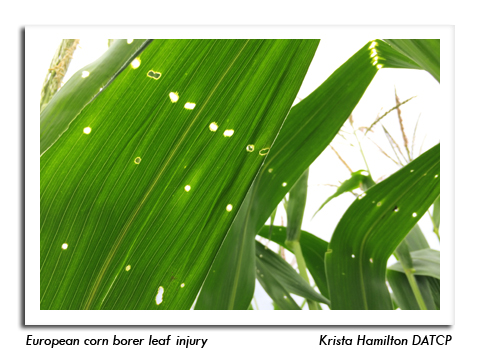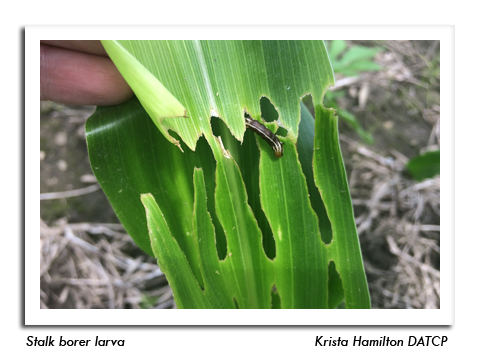
 |
|
|
Corn
Volume 57 Number 11 Date 06/21/2012 EUROPEAN CORN BORER - Surveys conducted in the northwest and west-central counties of Chippewa, Dunn, Eau Claire, Pepin, Pierce, Polk and St. Croix revealed very light infestations of 1-14 per 100 plants, with 74% of fields examined having no detectable population. Development of this insect has been accelerated by as much as 2-3 weeks this season, and first generation larvae are already entering the midribs of corn leaves. The treatment window has closed in the southern and west-central areas of the state with the accumulation of 1,100 degree days (base 50°F). CORN ROOTWORM - Beetles of the western species were noted on June 20 in Vernon County. Emergence of this insect and the related northern corn rootworm will increase gradually during the next 3-4 weeks and may peak as early as mid- to late July. Research entomologists anticipate increased populations of the western species this year, citing higher populations in 2012, favorable overwintering conditions and drier soils as factors contributing to their recent resurgence in Wisconsin and the Midwest. STALK BORER - Damage to corn has become more pronounced as larvae approach maturity. Examination of V5-9 corn fields found infestation rates of 2-20%, with the highest population noted near Mauston in Juneau County. Spot treatment is no longer effective for many south-central fields since the larvae have bored into the stalks and unemerged tassels. Controls must be applied from 1,400-1,700 degree days (base 41°F), or prior to the V7 stage. Stalk borer feeding is unlikely to kill corn plants beyond V7. ZEBRA CATERPILLAR - This infrequent pest with prominent black and yellow longitudinal stripes was defoliating corn leaves in the Coleman area of Marinette County on June 15. Larvae feed during the day on the foliage of a variety of broadleaf field and vegetable crops, ornamental trees and flowers, causing ragged leaves. The young caterpillars initially feed together in groups, but later separate and feed individually. The zebra caterpillar occurs sporadically in Wisconsin and is generally not considered a serious pest. HAIL DAMAGE - Severe weather in the form of thunderstorms, strong winds and hail affected portions of northeast Wisconsin on June 18. Large hail stones measuring 1.0-1.6 inches in diameter caused extensive damage to corn, soybeans, corn and other crops. Damage assessments in corn should not be made for at least 7-10 days to allow time for plants to show noticeable recovery. --Krista Hamilton, DATCP Entomologist 





|
|
|